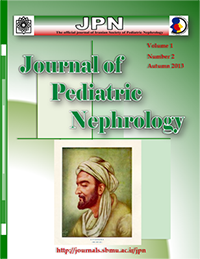Blood Chemical Analysis in Children with Acute Gastroenteritis, When Is It Useful?
Journal of Pediatric Nephrology,
Vol. 1 No. 2 (2013),
16 November 2013
,
Page 65-69
https://doi.org/10.22037/jpn.v1i2.4601
Abstract
Introduction: Acute gastroenteritis (AGE) is one of the most common diseases in children. Intravenous (IV) fluid therapy may be indicated in some of them. The aims of this study were to assess the usefulness of blood chemical analysis (blood glucose, urea, creatinine, sodium, potassium and bicarbonate) and to define any clinical criterion that helps to predict usefulness before starting IV fluid therapy.
Materials and Methods: A cross sectional study was conducted at the Emergency Department of Bahrami Children Hospital from March 2011 to June 2012; all children with AGE who were between 3 months to 10 years without any underlying diseases were enrolled in the study. Demographic variables, medical history and physical examination, laboratory tests results, and dehydration grading (according to the World Health Organization criteria) were noted. The usefulness of laboratory tests was defined as any change in the treatment plan due to laboratory results.
Results: Four hundred and fifty nine children (55.3% boys, 44.7% girls, mean age 25.36 months) were assessed. There were statistically significant associations between the usefulness of tests and patients' age, frequency of passing diarrheal stool in the last 24 hours, and dehydration grade (p<0.001). Only dehydration grade could significantly predict usefulness according to a logistic regression model (p<0.05).
Conclusions: According to these results, routine blood chemical analysis may be useful in patients with moderate to severe dehydration.
Keywords: Gastroenteritis; Child; Blood Chemical Analysis
How to Cite
References
Kosek M, Bern C, Guerrant RL. The global burden of diarrheal disease, as estimated from studies published between 1992 and 2000. Bull World Health Organ 2003; 81:197--204.
Hosseinpoor AR, Van Doorslaer E, Speybroeck N, et al. Decomposing socioeconomic inequality in infant mortality in Iran. Int J Epidemiol 2006, Oct; 35:1211-1219.
Jafari N, Abolhassani F, Naghavi M, et al. National Burden of Disease and Study in Iran. Iranian J Publ Health 2009;38(Suppl. 1):71-73.
Mortality country fact sheet: Islamic Republic of Iran. World Health Statistics 2006. World Health Organization. En .wikipedia.org/ wiki/ Health_care_in_Iran
Hamkar R, Yahyapour Y, Noroozi M, Nourijelyani K, Jalilvand S, Adibi L and etal. Prevalence of Rotavirus, Adenovirus, and Astrovirus Infections among Patients with Acute Gastroenteritis in, Northern Iran Iranian J Publ Health 2010;39(2):45-51.
Saneian H, Yaghini O, Yaghini A, Modarresi MR, Soroshnia M. Infection Rate of Cryptosporidium parvum among Diarrheic Children in Isfahan. Iranian Journal of Pediatrics 2010; 20 (3): 343-347..
Teach SJ, Yates EW, Feld LG. Laboratory predictors of fluid deficit in acutely dehydrated children. ClinPediatr (Phila) 1997; 36: 395-400.
King CK, Glass R, Bresee JS, Duggan C. Managing acute gastroenteritis among children. Oral Rehydration, Maintenance, and Nutritional Therapy. National Center for Infectious Diseases 2003; 52(RR16):1-16.
Wathen JE, MacKenzie T, Bothner JP. Usefulness of the serum electrolyte panel in the management of pediatric dehydration treated with intravenously administered fluids. Pediatrics 2004; 114:1227–1234.
World Health Organization. The treatment of diarrhoea: a manual for physicians and other senior health workers, 4th rev. Geneva, Switzerland: WHO; 2005.
Steiner MJ, DeWalt DA. Use of Serum Electrolyte Panels in Gastroenteritis. Pediatrics 2005; 115: 1108-1109.
Marín del Barrio S, González Carretero P, Garrido Romero R, Juma Azara KM, Luaces Cubells C. Usefulness of acid-base and electrolyte balance in acute gastroenteritis. An Pediatr (Barc) 2008; 69(4): 322-328.
Shah GS, Das BK, Kumar S, Singh MK, Bhandari GP. Acid base and electrolyte disturbance in diarrhea. Kathmandu University Medical Journal 2007; 5(1): 60-62.
Ukarapol N, Wongsawasdi L, Chartapisak W, Opastirakul S. Electrolyte abnormalities in children with acute diarrhea. Chiang Mai Med Bull 2002; 41(1):7-12.
Armon K, Stephenson T, MacFaul R, Eccleston P, Werneke U. An evidence and consensus based guideline for acute diarrhea management. Arch Dis Child. 2001; 85:132–142.
Gorelick MH, Shaw KN, Murphy KO. Validity and reliability of clinical signs in the diagnosis of dehydration. Pediatrics 1997; 99 (5). Available at: www.pediatrics.org/cgi/content/full/99/5/e6
Duggan C, Refat M, Hashem M, Wolff M, Fayad I, Santosham M. How valid are clinical signs of dehydration in infants? J Pediatr Gastroenterol Nutr. 1996; 22 (1):56 –61.
Burkhart DM. Management of Gastroenteritis in Children. Am Fam Physician 1999; 60: 2555-2566.
Acute Gastroenteritis Guideline Team. Cincinnati Children's Hospital Medical Center. Evidence-based care guidelines. Gastroenteritis. 2005. www.cincinnatichildrens.org/assets
Elliot EJ. Acute gastroenteritis in children. BMJ 2007; 334(7583): 35–40.
Carmeli Y, Samore M, Shoshany O, Rajs A, Stalnikowitz D. Utility of clinical symptoms versus laboratory tests for evaluation of acute gastroenteritis. Dig Dis Sci 1996; 41:1749-53.
Holliday M. The evolution of therapy for dehydration: should deficit therapy still be taught? Pediatrics 1996; 98: 171-7.
- Abstract Viewed: 298 times
- PDF Downloaded: 175 times

